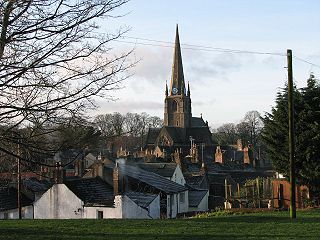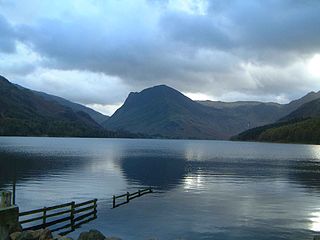
Carlisle is a border city and the county town of Cumbria as well as the administrative centre of the City of Carlisle district in North West England. Carlisle is located at the confluence of the rivers Eden, Caldew and Petteril, 10 miles (16 km) south of the Scottish border. Originally in the historic county of Cumberland, it is now the largest settlement in the county of Cumbria, and serves as the administrative centre for both Carlisle City Council and Cumbria County Council. At the time of the 2001 census, the population of Carlisle was 71,773, with 100,734 living in the wider city. Ten years later, at the 2011 census, the city's population had risen to 75,306, with 107,524 in the wider city.

Cumbria is a ceremonial and non-metropolitan county in North West England. The county and Cumbria County Council, its local government, came into existence in 1974 after the passage of the Local Government Act 1972. Cumbria's county town is Carlisle, in the north of the county; the only other major urban area is Barrow-in-Furness on the south-western tip of the county.
The toponymy of England derives from a variety of linguistic origins. Many English toponyms have been corrupted and broken down over the years, due to language changes which have caused the original meanings to be lost. In some cases, words used in these place names are derived from languages that are extinct, and of which there are no known definitions. Place names may also be compounds composed of elements derived from two or more languages from different periods. The majority of the toponyms predate the radical changes in the English language triggered by the Norman Conquest, and some Celtic names even predate the arrival of the Anglo-Saxons in the first millennium AD.

Millom is a town and civil parish on the north shore of the estuary of the River Duddon in southwest Cumbria, historically part of Cumberland, England. It is situated just outside the Lake District National Park, about 6 miles (9.7 km) north of Barrow-in-Furness and 26 miles (41.8 km) south of Whitehaven.
Cumbric was a variety of the Common Brittonic language spoken during the Early Middle Ages in the Hen Ogledd or "Old North" in what is now Northern England and southern Lowland Scotland. It was closely related to Old Welsh and the other Brittonic languages. Place name evidence suggests Cumbric may also have been spoken as far south as Pendle and the Yorkshire Dales. The prevailing view is that it became extinct in the 12th century, after the incorporation of the semi-independent Kingdom of Strathclyde into the Kingdom of Scotland. However, that is only in a primary and Official capacity where it is claimed to have survived until the 1800's when the last speaker died.

Cockermouth is an ancient market town and civil parish in the Borough of Allerdale in Cumbria, England, so named because it is at the confluence of the River Cocker as it flows into the River Derwent. The mid-2010 census estimates state that Cockermouth has a population of 8,204, increasing to 8,761 at the 2011 Census.

Penrith is a market town and civil parish in the county of Cumbria, England. It lies less than 3 miles (5 km) outside the bounds of the Lake District National Park. Historically in Cumberland, Penrith's local authority is currently Eden District Council, which is based in the town. Penrith was formerly the seat of Penrith Urban and Rural District councils. From 1974 to 2015, it was an unparished area with no town council, but a civil parish was reintroduced as Penrith Town Council and first elected on 7 May 2015.

Maryport is a town and civil parish in the Allerdale borough of Cumbria, England, historically in Cumberland.

Buttermere is a lake in the Lake District in North West England. The adjacent village of Buttermere takes its name from the lake. Historically in Cumberland, the lake is now within the county of Cumbria. Owned by the National Trust, it forms part of its Buttermere and Ennerdale property.

Ravenglass is a small coastal village and natural harbour in Cumbria, England, roughly halfway between Barrow-in-Furness and Whitehaven. Historically in Cumberland, it is the only coastal town in the Lake District National Park. It is located at the estuary of three rivers: the Esk, Mite and Irt.

The English language in Northern England has been shaped by the region's history of settlement and migration, and today encompasses a group of related dialects known as Northern England English. Historically, the strongest influence on the varieties of the English language spoken in Northern England was the Northumbrian dialect of Old English, but contact with Old Norse during the Viking Age and with Irish English following the Great Famine have produced new and distinctive styles of speech. Some "Northern" traits can be found further south than others: only conservative Northumbrian dialects retain the pre-Great Vowel Shift pronunciation of words such as town, but all northern accents lack the FOOT–STRUT split, and this trait extends a significant distance into the Midlands.

Shap is a linear village and civil parish located among fells and isolated dales in Eden district, Cumbria, England, in the historic county of Westmorland.

St Bees is a coastal village, civil parish and electoral ward in the Copeland district of Cumbria, England, on the Irish Sea. It was originally in the historic county of Cumberland.

The Cumberland dialect is a local Northern English dialect in decline, spoken in Cumberland, Westmorland and surrounding northern England, not to be confused with the area's extinct Celtic language, Cumbric. Some parts of Cumbria have a more North-East English sound to them. Whilst clearly spoken with a Northern English accent, it shares much vocabulary with Scots. A Cumbrian Dictionary of Dialect, Tradition and Folklore by William Rollinson exists, as well as a more contemporary and lighthearted Cumbrian Dictionary and Phrase Book.

Cumbrian toponymy refers to the study of place names in Cumbria, a county in North West England, and as a result of the spread of the ancient Cumbric language, further parts of northern England and the Southern Uplands of Scotland.

The history of Cumbria as a county of England begins with the Local Government Act 1972. Its territory and constituent parts however have a long history under various other administrative and historic units of governance. Cumbria is an upland, coastal and rural area, with a history of invasions, migration and settlement, as well as battles and skirmishes between the English and the Scots.

Mawbray is a village in the civil parish of Holme St Cuthbert in Cumbria, England, historically part of Cumberland. It is located on the Solway Plain, 5.2 miles (8.4 km) south west of Silloth, 7.9 miles (12.7 km) north of Maryport, and 25 miles (40 km) west of Carlisle. The B5300, known locally as the "coast road" runs to the west of the village.

The history of medieval Cumbria has several points of interest. The region's status as a borderland coping with 400 years of warfare is one. The attitude of the English central government, at once uninterested and deeply interested, is another. As a border region, of geopolitical importance, Cumbria changed hands between the Angles, Norse, Strathclyde Brythons, Picts, Normans, Scots and English; and the emergence of the modern county is also worthy of study.












